Abstract
A monoclonal antibody, CC11.23, with monomorphic specificity predominantly for products of the HLA-DQ subregion, has been used to demonstrate primary structural variation among DQ molecules. Two cell lines of each haplotype (DR1-7) were radiolabeled with [3H]tyrosine. alpha and beta chains were isolated from CC11.23-reactive preparations, and their amino-terminal tyrosine sequences were determined. Each DR haplotype (with the exception of DRw6) was found to express a distinct DQ molecule with a minimum of three allelic forms of the DQ alpha chain and five allelic forms of the DQ beta chain. At the primary structural level, the locus for the DQ beta chain appears to be as polymorphic as the locus for the DR beta chain. Unlike the locus for the DR alpha chain (which is essentially nonpolymorphic), the locus for the DQ alpha chain was found to be polymorphic. Comparison of DQ molecules from two different heterozygous cell lines with those from homozygous cell lines revealed that in heterozygotes, DQ alpha chains from either allele can associate with DQ beta chains from one allele. The formation of hybrid HLA-DQ molecules by both cis and trans gene complementation, coupled with several polymorphic forms of each of the DQ subunits, considerably increases the repertoire of DQ alloantigens in heterozygotes.
Full text
PDF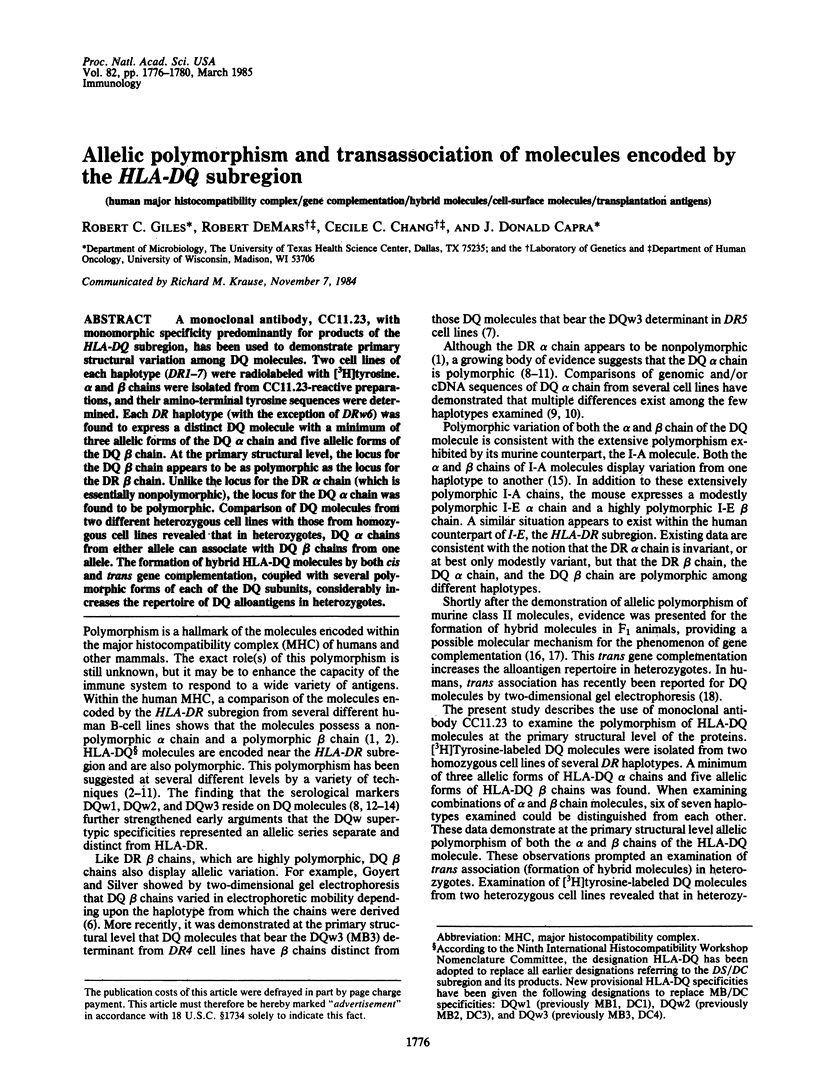
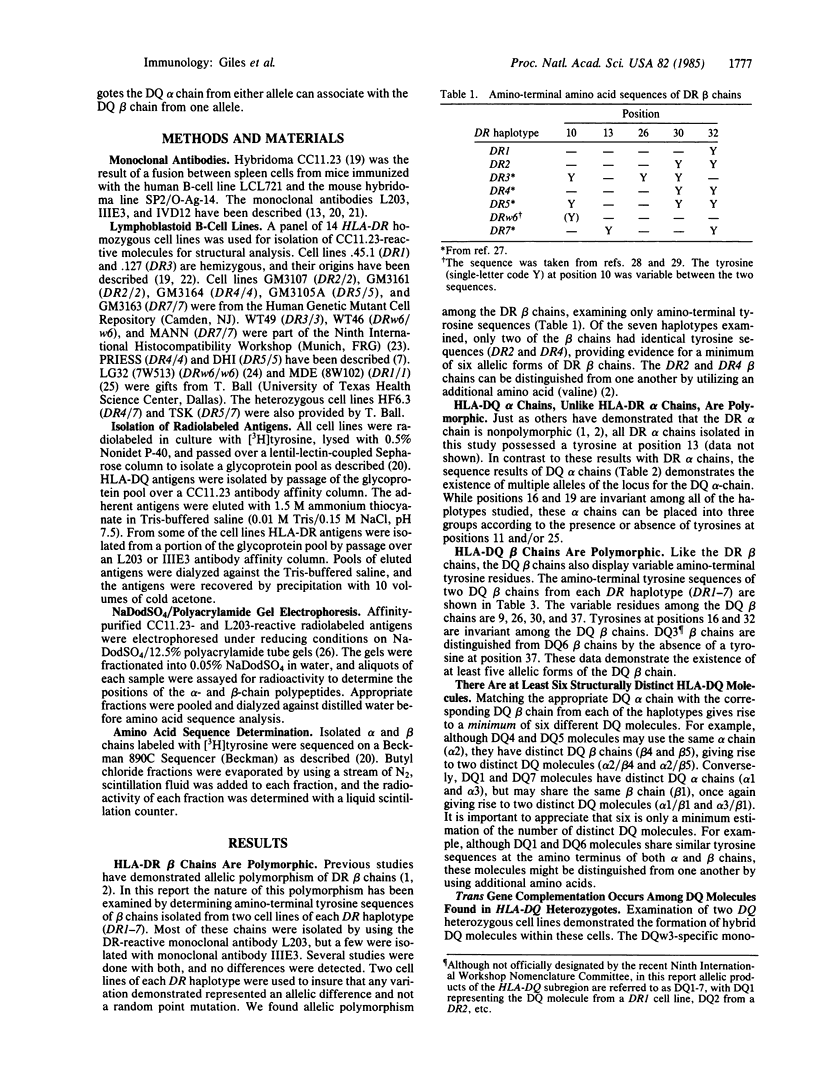
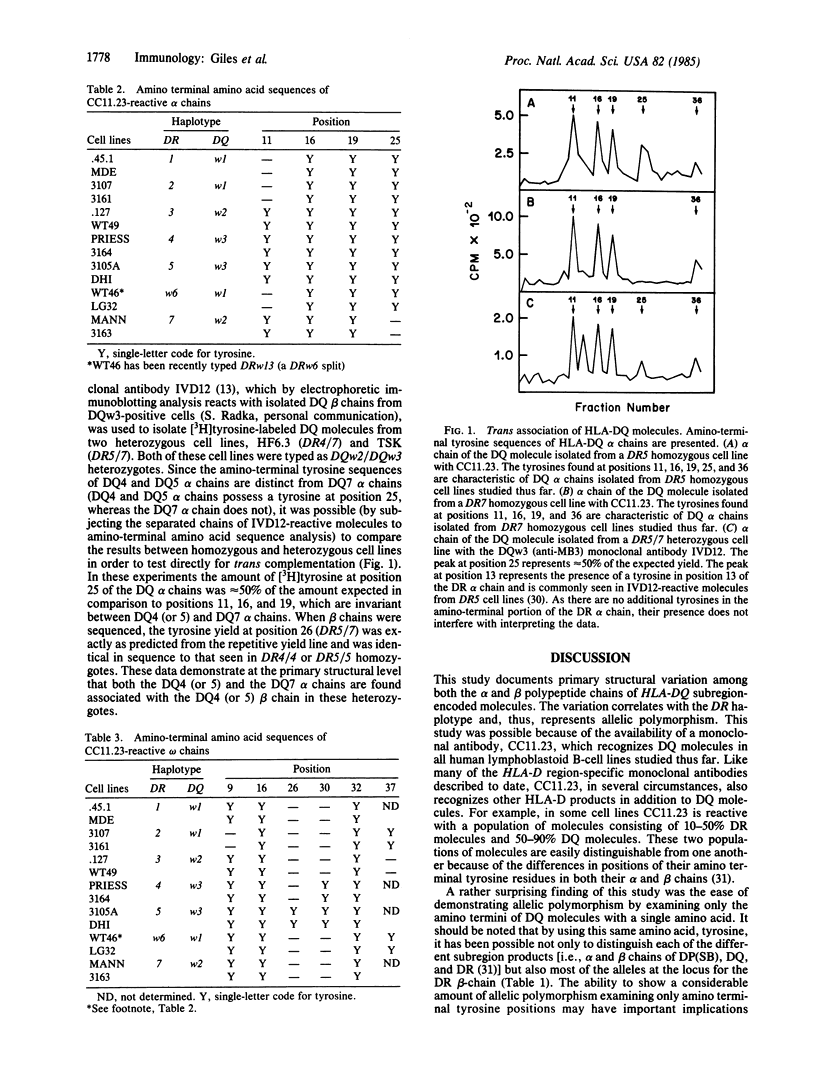
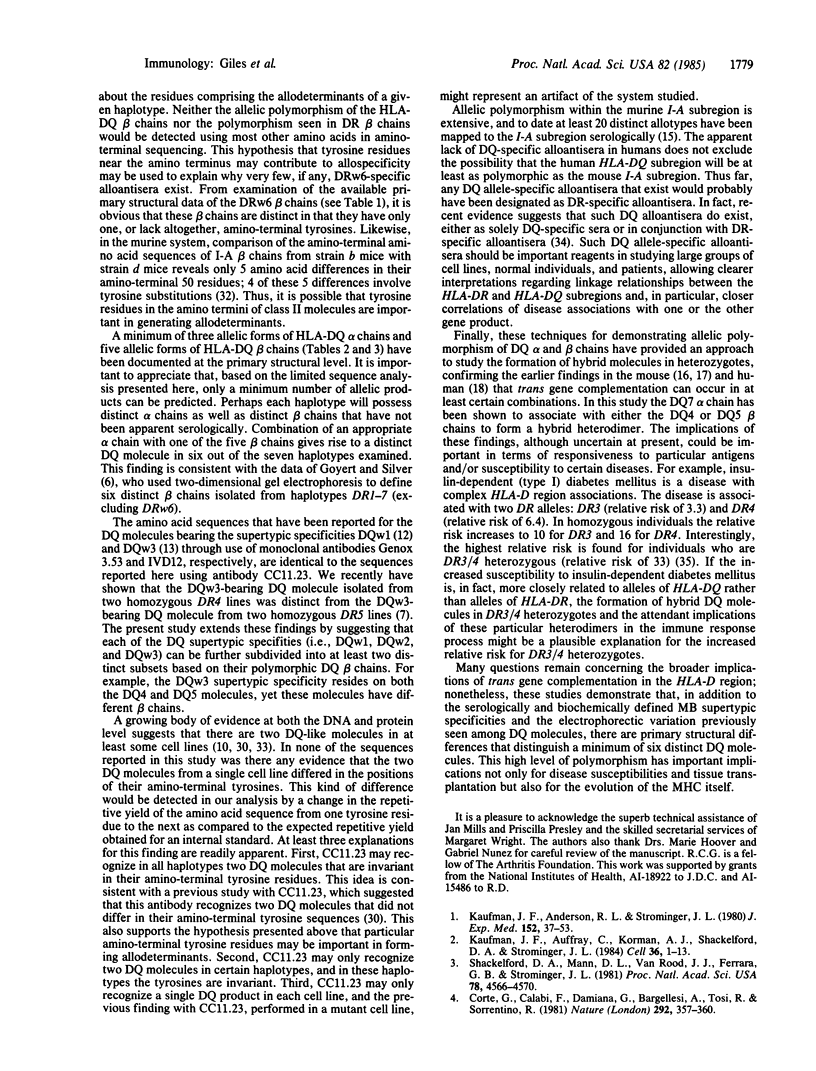
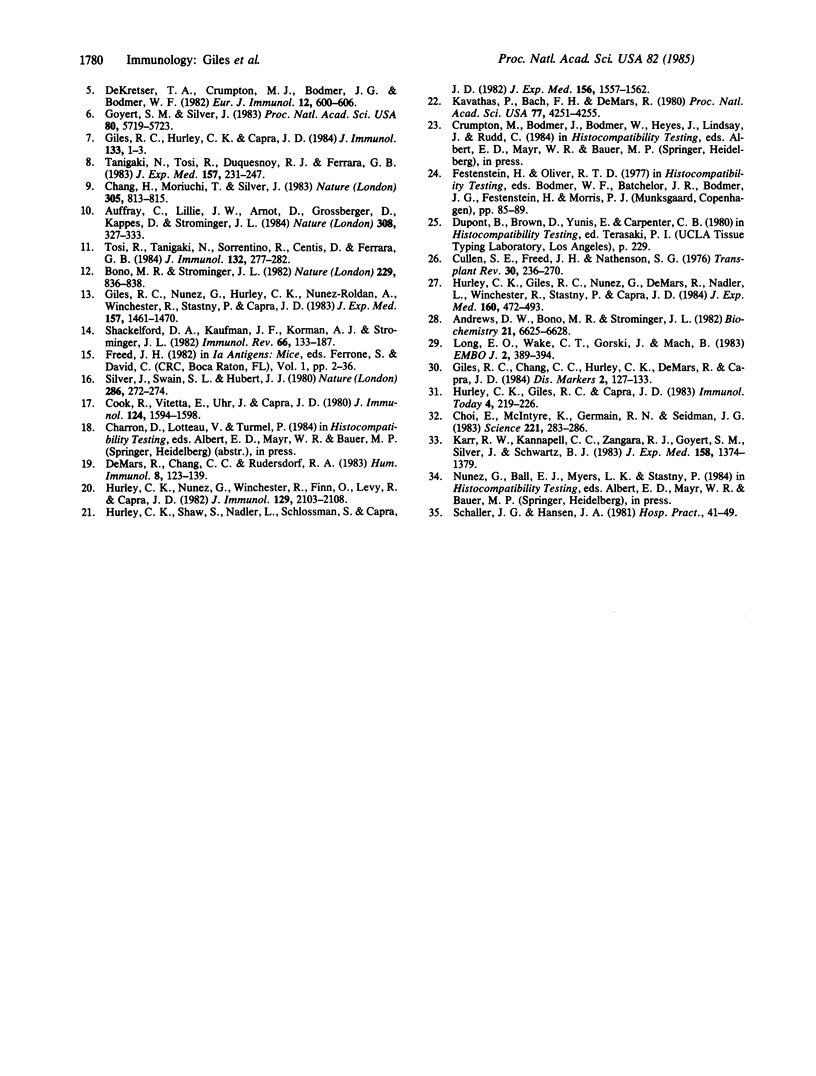
Selected References
These references are in PubMed. This may not be the complete list of references from this article.
- Andrews D. W., Bono M. R., Strominger J. L. A homozygous human cell line contains three subsets of HLA-DR-like antigens distinguishable by amino acid sequencing. Biochemistry. 1982 Dec 21;21(26):6625–6628. doi: 10.1021/bi00269a002. [DOI] [PubMed] [Google Scholar]
- Auffray C., Lillie J. W., Arnot D., Grossberger D., Kappes D., Strominger J. L. Isotypic and allotypic variation of human class II histocompatibility antigen alpha-chain genes. Nature. 1984 Mar 22;308(5957):327–333. doi: 10.1038/308327a0. [DOI] [PubMed] [Google Scholar]
- Bono M. R., Strominger J. L. Direct evidence of homology between human DC-1 antigen and murine I-A molecules. Nature. 1982 Oct 28;299(5886):836–840. doi: 10.1038/299836a0. [DOI] [PubMed] [Google Scholar]
- Chang H. C., Moriuchi T., Silver J. The heavy chain of human B-cell alloantigen HLA-DS has a variable N-terminal region and a constant immunoglobulin-like region. 1983 Oct 27-Nov 2Nature. 305(5937):813–815. doi: 10.1038/305813a0. [DOI] [PubMed] [Google Scholar]
- Choi E., McIntyre K., Germain R. N., Seidman J. G. Murine I-A beta chain polymorphism: nucleotide sequences of three allelic I-A beta genes. Science. 1983 Jul 15;221(4607):283–286. doi: 10.1126/science.6407114. [DOI] [PubMed] [Google Scholar]
- Cook R. G., Vitetta E. S., Uhr J. W., Capra J. D. Structural studies on the murine Ia alloantigens. VII. Further evidence for two-gene control of the E/C alloantigens. J Immunol. 1980 Apr;124(4):1594–1598. [PubMed] [Google Scholar]
- Corte G., Calabi F., Damiani G., Bargellesi A., Tosi R., Sorrentino R. Human Ia molecules carrying DC1 determinants differ in both alpha- and beta-subunits from Ia molecules carrying DR determinants. Nature. 1981 Jul 23;292(5821):357–360. doi: 10.1038/292357a0. [DOI] [PubMed] [Google Scholar]
- Cullen S. E., Freed J. H., Nathenson S. G. Structural and serological properties of murine Ia alloantigens. Transplant Rev. 1976;30:236–270. doi: 10.1111/j.1600-065x.1976.tb00222.x. [DOI] [PubMed] [Google Scholar]
- De Kretser T. A., Crumpton M. J., Bodmer J. G., Bodmer W. F. Two-dimensional gel analysis of the polypeptides precipitated by a polymorphic HLA-DR1,2,w6 monoclonal antibody: evidence for a third locus. Eur J Immunol. 1982 Jul;12(7):600–606. doi: 10.1002/eji.1830120713. [DOI] [PubMed] [Google Scholar]
- DeMars R., Chang C. C., Rudersdorf R. A. Dissection of the D-region of the human major histocompatibility complex by means of induced mutations in a lymphoblastoid cell line. Hum Immunol. 1983 Oct;8(2):123–139. doi: 10.1016/0198-8859(83)90008-3. [DOI] [PubMed] [Google Scholar]
- Giles R. C., Hurley C. K., Capra J. D. Primary structural variation among serologically indistinguishable DS antigens: the MB3-bearing molecule in DR4 cells differs from the MB3-bearing molecule in DR5 cells. J Immunol. 1984 Jul;133(1):1–3. [PubMed] [Google Scholar]
- Giles R. C., Nunez G., Hurley C. K., Nunez-Roldan A., Winchester R., Stastny P., Capra J. D. Structural analysis of a human I-A homologue using a monoclonal antibody that recognizes an MB3-like specificity. J Exp Med. 1983 May 1;157(5):1461–1470. doi: 10.1084/jem.157.5.1461. [DOI] [PMC free article] [PubMed] [Google Scholar]
- Goyert S. M., Silver J. Further characterization of HLA-DS molecules: implications for studies assessing the role of human Ia molecules in cell interactions and disease susceptibility. Proc Natl Acad Sci U S A. 1983 Sep;80(18):5719–5723. doi: 10.1073/pnas.80.18.5719. [DOI] [PMC free article] [PubMed] [Google Scholar]
- Hurley C. K., Giles R. C., Nunez G., DeMars R., Nadler L., Winchester R., Stastny P., Capra J. D. Molecular localization of human class II MT2 and MT3 determinants. J Exp Med. 1984 Aug 1;160(2):472–493. doi: 10.1084/jem.160.2.472. [DOI] [PMC free article] [PubMed] [Google Scholar]
- Hurley C. K., Nunez G., Winchester R., Finn O. J., Levy R., Capra J. D. The human HLA-DR antigens are encoded by multiple beta-chain loci. J Immunol. 1982 Nov;129(5):2103–2108. [PubMed] [Google Scholar]
- Hurley C. K., Shaw S., Nadler L., Schlossman S., Capra J. D. Alpha and beta chains of SB and DR antigens are structurally distinct. J Exp Med. 1982 Nov 1;156(5):1557–1562. doi: 10.1084/jem.156.5.1557. [DOI] [PMC free article] [PubMed] [Google Scholar]
- Karr R. W., Kannapell C. C., Zangara R. J., Goyert S. M., Silver J., Schwartz B. D. An HLA-DR5 homozygous cell line expresses two DS (I-A-like) molecules. J Exp Med. 1983 Oct 1;158(4):1374–1379. doi: 10.1084/jem.158.4.1374. [DOI] [PMC free article] [PubMed] [Google Scholar]
- Kaufman J. F., Auffray C., Korman A. J., Shackelford D. A., Strominger J. The class II molecules of the human and murine major histocompatibility complex. Cell. 1984 Jan;36(1):1–13. doi: 10.1016/0092-8674(84)90068-0. [DOI] [PubMed] [Google Scholar]
- Kavathas P., Bach F. H., DeMars R. Gamma ray-induced loss of expression of HLA and glyoxalase I alleles in lymphoblastoid cells. Proc Natl Acad Sci U S A. 1980 Jul;77(7):4251–4255. doi: 10.1073/pnas.77.7.4251. [DOI] [PMC free article] [PubMed] [Google Scholar]
- Long E. O., Wake C. T., Gorski J., Mach B. Complete sequence of an HLA-dR beta chain deduced from a cDNA clone and identification of multiple non-allelic DR beta chain genes. EMBO J. 1983;2(3):389–394. doi: 10.1002/j.1460-2075.1983.tb01435.x. [DOI] [PMC free article] [PubMed] [Google Scholar]
- Schaller J. G., Hansen J. A. HLA relationships to disease. Hosp Pract (Off Ed) 1981 May;16(5):41–49. doi: 10.1080/21548331.1981.11946769. [DOI] [PubMed] [Google Scholar]
- Shackelford D. A., Kaufman J. F., Korman A. J., Strominger J. L. HLA-DR antigens: structure, separation of subpopulations, gene cloning and function. Immunol Rev. 1982;66:133–187. doi: 10.1111/j.1600-065x.1982.tb00437.x. [DOI] [PubMed] [Google Scholar]
- Shackelford D. A., Mann D. L., van Rood J. J., Ferrara G. B., Strominger J. L. Human B-cell alloantigens DC1, MT1, and LB12 are identical to each other but distinct from the HLA-DR antigen. Proc Natl Acad Sci U S A. 1981 Jul;78(7):4566–4570. doi: 10.1073/pnas.78.7.4566. [DOI] [PMC free article] [PubMed] [Google Scholar]
- Silver J., Swain S. L., Hubert J. J. Small subunit of I-A subregion antigens determines the allospecificity recognized by a monoclonal antibody. Nature. 1980 Jul 17;286(5770):272–274. doi: 10.1038/286272a0. [DOI] [PubMed] [Google Scholar]
- Tanigaki N., Tosi R., Duquesnoy R. J., Ferrara G. B. Three Ia species with different structures and alloantigenic determinants in an HLA-homozygous cell line. J Exp Med. 1983 Jan 1;157(1):231–247. doi: 10.1084/jem.157.1.231. [DOI] [PMC free article] [PubMed] [Google Scholar]
- Tosi R., Tanigaki N., Sorrentino R., Centis D., Ferrara G. B. Serologically detectable polymorphism of the HLA-DC alpha-subunit. J Immunol. 1984 Jan;132(1):277–282. [PubMed] [Google Scholar]


